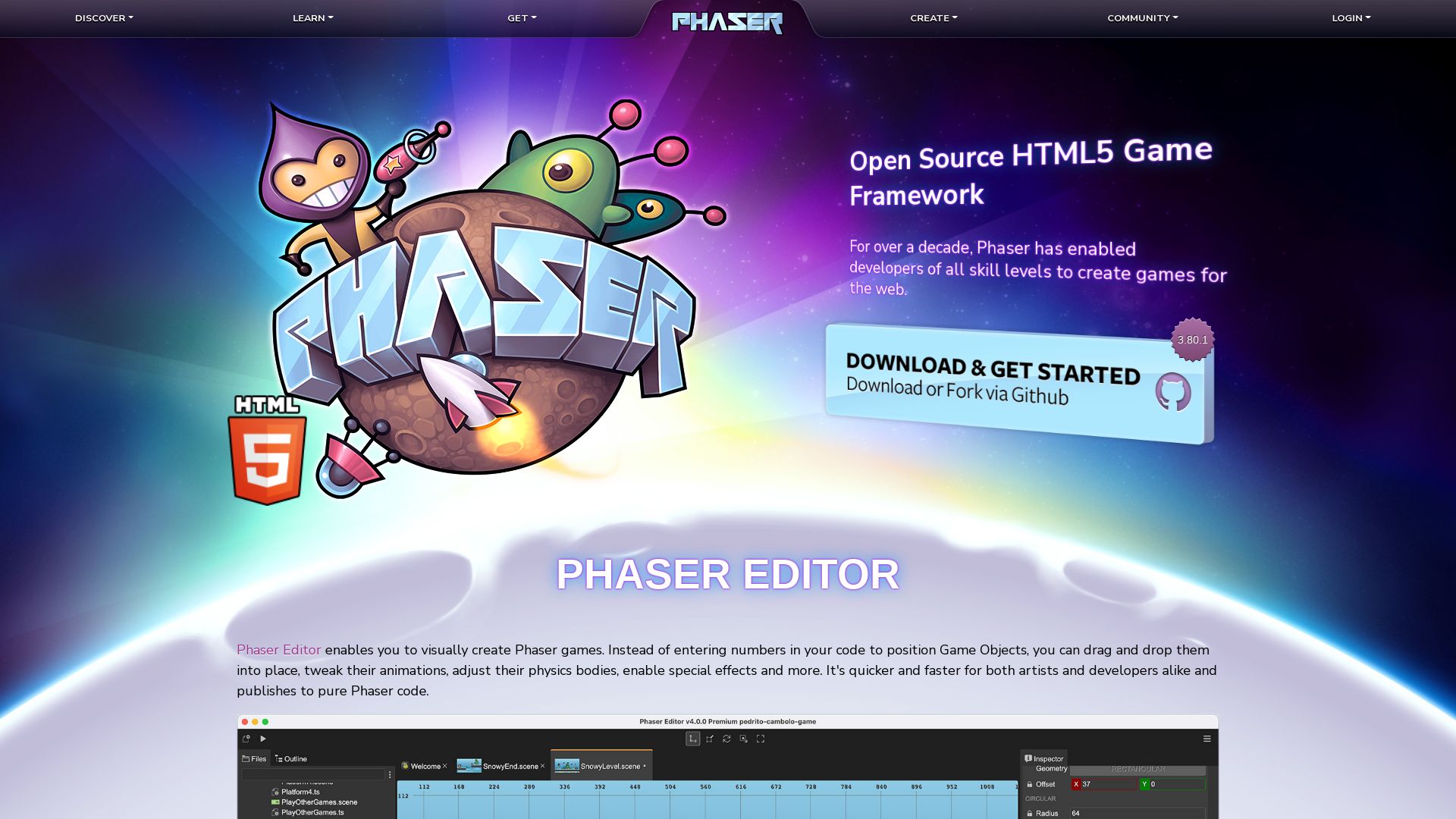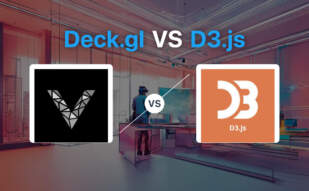
D3.js
Founded in 2011 by Mike Bostock, Jason Davies, and Jeffrey Heer, D3.js(Data-Driven Documents) is a robust JavaScript library specifically designed for creating dynamic, interactive data visualizations that are rendered in web browsers.
D3.js Top Features
- SVG Graphics Generation: Utilizes SVG, HTML5, CSS standards for finest quality graphics.
- Data-Driven: Enables binding of large datasets to SVG objects via D3.js functions.
- Elements Selection: Efficient element selection through CSS-style selectors.
- Data Binding: Advanced loaded data-driven element creation for precise control.
- Transitions: Allows smooth interpolation of values for attributes and styles over time.
| Flexibility | D3.js provides maximum flexibility by allowing you to compose individual primitives to visualize data. |
| Web Standards Utilization | Providing the benefits of using external stylesheets for alteration in appearance. |
| Intuitive Evaluation | Synchronous and imperative evaluation for effective debugging and editing. |
D3.js Downsides
- Complexity: Not a simple charting library. Requires a deeper understanding of data visualization.
- Overkill: For private dashboards or one-off analyses, D3.js might be an overkill.
- Learning Curve: Users might find a steeper learning curve due to its entirety relying on web standards.
D3.js Pricing
As a true testament to community-led technological innovation, D3.js is a free, open-source library.
D3.js Use Cases
Media Organizations
For media organizations that require dynamic, interactive visualizations, D3.js provides the necessary tools and functionality.
Academia
D3.js is a strong choice within academia, providing students and researchers a very detailed mechanism for interactive data visualization.
Data Visualization Practitioners
D3.js meets the needs of data visualization practitioners, allowing them to bind large datasets to documents for complex visual representation of data.
PixiJS
An eminent member of the Web Graphics Technology arena, PixiJS is a dynamic, performance-oriented, WebGL and Canvas rendering system. Perfect for 2D visuals, it is a viable alternative to Mo.js for graphics-heavy web applications, online games, interactive ads, and educational content.
PixiJS Top Features
- Speed: Employs automatic sprite & geometry batching for optimal WebGL utilization, offering faster performance.
- Graphics Beyond Sprites: Provides text rendering and enables drawing trails, primitives along with ease of loading via native spritesheets.
- Advanced Effects: Facilitates fast rendering and advanced effects through its Filter class and shader programs.
- Open Source: Fully accessible and extensible code hosted on GitHub under an MIT license.
- Easy Deployment: Its website-like deployment can also be extended to mobile & desktop apps via Cordova & Electron.
| Feature | Description |
|---|---|
| Learning Resources | Extensive educational resources available via the official website, tutorials, API guide, Wiki, and discord chat. |
| Setup | Allows versatile setup methods, including download prebuild build, npm install, and CDN URL use. |
PixiJS Downsides
- Despite its extensive feature set, PixiJS is not a full-fledged game engine.
- Complex projects might demand a steep learning curve.
PixiJS Pricing
Rejoice, coders! PixiJS is open source and available free of charge. However, financial contributions are welcome to help accelerate the future development of this dynamic system.
PixiJS Use Cases
Use case 1: Interactive Content
With PixiJS, creating interactive content becomes a breeze thanks to its focus on speed and 2D visuals rendering.
Use case 2: Cross-Platform Applications
Want to develop applications with cross-platform compatibility? PixiJS, in conjunction with Cordova and Electron, does just that.
Use case 3: Online Games
For developers in the online gaming sphere, PixiJS’s ability to deliver high-quality, graphics-heavy performance is a game changer.
Phaser

Established in April 2013 by Richard Davey, Phaser is a highly flexible 2D game framework that employs JavaScript and TypeScript for creating HTML5 games swiftly deployable to desktop and mobile platforms.
Phaser Top Features
- Employs Canvas and WebGL renderer for faster rendering.
- Crafts games playable on iOS, Android, and native desktop apps via tools such as Apache Cordova and PhoneGap.
- Versatile browser compatibility; functions with anyone that supports the canvas element.
- Presents an array of physics systems including Arcade Physics, Ninja Physics, and P2.JS.
- Game development made simpler with over 1800 practical examples and an active community support.
| Phaser Version | Key Features |
|---|---|
| Phaser 1 | Incorporates Pixi.js library |
| Phaser 2.6.2 | Last official Phaser 2 version |
| Phaser CE (Community Edition) | Current recommended stable platform |
Phaser Downsides
- Complexity may prove challenging for novices in game development.
- Swift evolution of versions might lead to issues with backwards compatibility.
Phaser Pricing
Phaser is open-source and available for free, making it a tractable option for developers.
Phaser Use Cases
Use Case 1: Desktop and Mobile Games
Phaser’s smooth deployment to iOS and Android platforms makes it an ideal choice for developers seeking to create engaging desktop and mobile games.
Use Case 2: Browser-Compatible Games
Phaser’s extensive compatibility with any browser that supports the canvas element renders it well-suited for the development of browser-compatible games.
Use Case 3: Physics-Based Games
The variety of physics systems offered in the Phaser framework eases the creation of intricate physics-based games.
Phaser 3

Unleash your game developing prowess with Phaser 3, a next-generation game development framework, equipped with a data-oriented approach and a custom WebGL renderer designed for the cutting-edge 2D games of today.
Phaser 3 Top Features
- Modern 2D Games: The next-gen WebGL renderer brings your 2D games to life.
- Modular Structure: Everything is rebuilt using a modular structure, everything!
- Extensive Resources: Phaser 3 offers rich resources for learning, such as a Getting Started guide and a tutorial for making your first game.
| Feature | Benefit |
|---|---|
| Open Source | Affords greater freedom to manipulate the code and innovate. |
| V3.50 | Latest release with significant updates and bug fixes. |
| Multiple Renderers | Supports both Canvas and WebGL, swapping based on browser support. |
Phaser 3 Downsides
- Some API changes can cause breaking changes, although most are internal.
- While it makes game development quicker, Phaser 3 might not be the best fit for highly complex games.
Phaser 3 Pricing
Hold your breath! Phaser 3 is a free software. Yes, you read it right. Free. Let your imagination run wild with this open-source game framework
Phaser 3 Use Cases
Use case 1
If you are beginner seeking to master game-development, Phaser 3 with its ease of use and rich learning resources, is your perfect launchpad. It lets you dive head-on into game development with minimal hiccups.
Use case 2
Chasing a commitment to deliver a lightweight game to market quickly? Phaser 3, with its simplified yet powerful framework is your ideal pick. It helps you create engaging 2D HTML5 games for desktop and mobile.
Use case 3
Are you a part of the vibrant JavaScript or TypeScript fraternity of developers, seeking an attractively featured framework? Look no further, Phaser 3 supports both languages for development!
Konva

Konva is a powerful HTML5 Canvas JavaScript framework that powers interactivity in desktop and mobile apps. It offers an impressive range of features such as high-performance animations, transitions, node nesting, and more.
Top Features of Konva
- Interactivity and Animations: Konva supports dynamic animations, transitions, and interactive capabilities across platforms.
- Node Nesting and Layering: With Konva, you can create complex scene graph hierarchies with layering and node nesting.
- Shape Flexibility: Konva offers prebuilt shapes and allows for custom shape creation with its Shape class.
- Event Handling: Event detection is utilised through a hit graph renderer.
- Advanced Filters: A range of filters such as blur, invert, and noise can be applied.
| Feature | Description |
|---|---|
| Style Properties | Styling options include fills, strokes, shadows, and opacity. |
| Drag Support | Built-in drag support with simplicity. Initiate drag and drop with ‘draggable = true’. |
| Performance Improvement | Methods like caching and layering help enhance performance. |
Konva Disadvantages
- Lack of Drop Events: Despite providing drag support, it does not support drop events.
- Requires Coding Knowledge: The use of Konva demands proficiency in coding and understanding JavaScript.
Konva Use Cases
Use Case 1: Interactive Web Graphics
Designers and developers can use Konva for creating interactive web graphics, offering a seamless UX.
Use Case 2: Mobile App Development
For mobile app developers, Konva provides animations and transitions, improving app interactivity and engagement.
Use Case 3: Game Development
With its capabilities, Konva is beneficial for game developers as it allows creating high-performance animations and dynamic shape handling.
Canvas

An efficient tool for creating on-the-fly graphics, Canvas, leverages HTML5 and JavaScript to serve its purpose. Think path creation, interactivity, animations, and gaming applications, all possible with Canvas.
Canvas Top Features
- RenderingContext: Can’t display anything on Canvas? Use this.
- Different Styles: Enhance your graphics quality. Applies to all subpaths.
- HTML Canvas API: Makes pixel-level manipulation feasible. Majorly used for drawing raster graphics.
- Gradient Creation: Linear or radial, whatever you prefer.
- CanvasImageSource: Draws images directly to your Canvas.
| Path Methods | Intensity |
|---|---|
| arcTo() | High |
| lineTo() | Medium |
| rect() | Low |
Canvas Limitations
- Heavy Scripting: While Canvas houses graphics, the actual drawing needs scripting, mostly JavaScript.
- IE8 Compatibility: For IE8 to support Canvas, ExplorerCanvas script is mandatory.
Canvas Use Cases
Use case 1: Gaming Applications
Canvas’s interactivity and animation capabilities make it a robust tool for creating engaging gaming apps.
Use case 2: Data Visualization
Drawing paths, shapes, and text makes Canvas apt for implementing graphical data presentations.
Use case 3: Web Design
Its HTML5 attribute support, along with style and color options, enable web designers to create interactive and visually pleasing designs.
Cocos2d
Cocos2d is an open source software framework designed elegantly for the development of games, apps, and other cross-platform GUI programs. Conceived in 2008 by Los Cocos, it is lauded for its versatility, that is evident through its notable branches such as Cocos2d-objc, Cocos2d-x, Cocos2d-html5, and Cocos2d-XNA.
Cocos2d Top Features
- Animation and Graphical UI: Allows creation of dynamic scenes with its powerful animation system and graphical UI.
- Physics system: Provides the ability to integrate real-world physics into games.
- Cocos2d-x: A complete tool-chain for developing multi-platform games with speed and efficiency.
- Skeletal and sprite sheet animation: Supports 2D graphics with OpenGL and facilitates complex character animations.
- Cocos Creator: An open-source, customizable 2D/3D game engine to enhance game development.
| Feature | Benefit |
|---|---|
| Procedural Animation | Enables more natural and interactive motions. |
| High Precision Text | Improves clarity and legibility in games. |
| Google Play Instant | Facilitates game trials without downloading. |
Cocos2d Limitations
- Despite being versatile, Cocos2d can be challenging for beginners due to its steep learning curve.
- There is a substantial dependency on community support, as it’s an open-source platform.
- Developing 3D games can prove to be arduous as Cocos2d primarily specializes in 2D environments.
Cocos2d Pricing
Being an open source platform, Cocos2d is available free of cost. It fosters a community of developers who collaboratively strive to enhance and refine the platform.
Cocos2d Use Cases
Use case 1: Game Development
Cocos2d is paramount for developing captivating 2D games, such as FarmVille and Geometry Dash, with its wide range of features and tools.
Use case 2: Cross-Platform Apps
The framework’s ability to craft cross-platform apps makes it an advantageous solution for developers seeking consistent app performance across diverse platforms.
Use case 3: Educational Purposes
Cocos2d, through its procedural animation and high precision text, is a conducive tool for creating educational apps that require finer details and interactivity.
Patrick Daugherty
Content writer @ Aircada. Merging AR expertise with a love for late-night gaming sessions.





